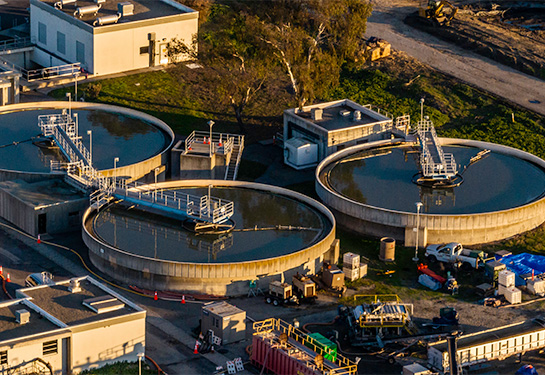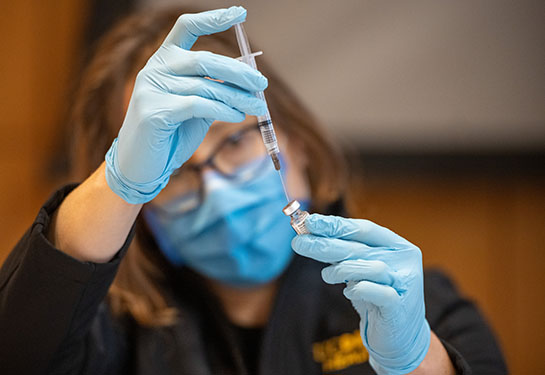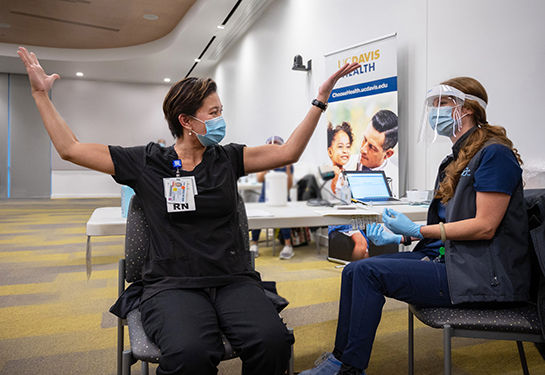Tracking COVID-19 in 2024: Wastewater data provides key early warning sign for surges
UC Davis Health clinical chemist explains how sewage surveillance helps health care providers respond to viral outbreaks
The secret is in the sewage. As COVID-19 evolves, wastewater testing has become a valuable tool in predicting regional surges of infection.
During the pandemic, health care facilities were required to report cases of COVID-19 to authorities. However, the number of reported infections has since diminished with more people using at-home antigen COVID tests and keeping the results to themselves.
Most people also now have some degree of immunity, due to vaccines or previous infections, and are less likely to seek medical care. This further reduces the ability to monitor community infection rates.
“Home testing definitely made it more challenging to gather reporting data,” said Nam Tran, professor and senior director of clinical pathology at UC Davis Health. “But tracking changed even more drastically at the federal level last May when the pandemic emergency was declared over.”
That’s because as of May 1, 2024, the Centers for Disease Control and Prevention (CDC) no longer requires reporting of COVID-19 hospital infection data, said Tran, a chemical scientist. The CDC does encourage facilities to continue voluntary reporting. And at the state level, several public health agencies still require some degree of COVID-19 reporting for hospitals and workplace settings.
An increasing reliance on wastewater testing to determine community spread
In 2020, the CDC set up a national wastewater testing program. It has now grown to more than 1,000 sites, including more than three dozen in California. The CDC works with local health departments to gather data.
According to the CDC, wastewater includes water from household or building use, like toilets, showers and sinks, and can include water from rain and industrial use as well. Water is collected as it flows into a treatment plant. Samples are then sent to public health or environmental labs for testing.
The CDC’s tracking site allows users to search results by state. Nationally, as of the week ending Aug. 17, the level of COVID in wastewater is considered “very high”; in California the levels are even higher than the national average.
“Wastewater is an impressive new tool that’s now become more mainstream because of the pandemic,” Tran said.
In this Q&A, Tran answers some common questions about wastewater tracking and why it’s helpful.
How does wastewater COVID surveillance work?
People with active SARS-CoV-2 infection shed the virus in their feces — even if they aren’t having symptoms. We can detect that virus in community wastewater by testing for the genetic make-up of the virus, which provides a good sense that the organism is there. However, this is not a definitive indication of an active infection. For example, we know that some diseases shed nucleic acids for a period of time but may not be symptomatic or infectious. Another challenge is that you are in some cases trying to find a needle in a haystack when disease prevalence is low.
As the pandemic progressed and the usefulness of wastewater testing became clearer, testing evolved to be more sensitive. Public health groups can transfer this technique to detect other pathogens as well.
Wastewater is an impressive new tool that’s now become more mainstream because of the pandemic. —Nam Tran, senior director of clinical pathology, UC Davis Health
How can health care workers and community leaders use wastewater data?
It provides trends and general indications that an organism may be in the community. So, if you see increasing amounts of a certain virus, for example, it can indicate disease burden and spread within the community. This can help providers to plan and prepare and be alert for people showing symptoms of the disease.
We must be mindful, though, that this is a pooled sample, so it reflects everything the population (including animals and the environment itself) are contributing to wastewater. It is most effective to use wastewater testing data in combination with other information, such as hospitalizations.
Why has wastewater testing for COVID become more important?
Wastewater testing, especially as infections surge, can detect the virus even when people do at-home tests that aren’t reported, or when they don’t seek medical attention. This allows wastewater testing to compliment the many tools we have in public health surveillance.
Is wastewater testing used to monitor other illnesses?
Yes, it’s being used to test for a variety of pathogens. Most recently, we are using this data to track influenza A, which may be a surrogate for potential risk for HPAI (H5N1) spread. The “SCAN Project” run by Stanford and Emory universities is a good example of the types of testing being done, including influenza, RSV, COVID, norovirus, MPOX and more — perhaps non-infectious diseases in the future.
At UC Davis Health, we use this data to corroborate what we are seeing at our various clinics in terms of respiratory illnesses like influenza, RSV, and COVID.
What do you see for the future of wastewater testing?
It comes down to what is the return on investment in terms of tracking potential illnesses. If we know a pathogen is increasing in prevalence, is wastewater data enough to help us stop the spread? It certainly increases our awareness and ability to plan, but it remains to be seen how it plays out long term since these testing solutions can be expensive. As we learned in 2020, we can’t test ourselves out of a pandemic. Wastewater is just one additional tool we have to inform public health decision-making.
Related Resources and Stories
- How wastewater testing works (CDC resource)
- What you need to know about the 2024-2025 COVID-19 vaccine recommendations (story and video featuring infectious diseases experts)
- Back to school 2024 amid a COVID surge: Latest symptoms and guidelines
- Federal government site to order free at-home antigen test kits, starting in late September






